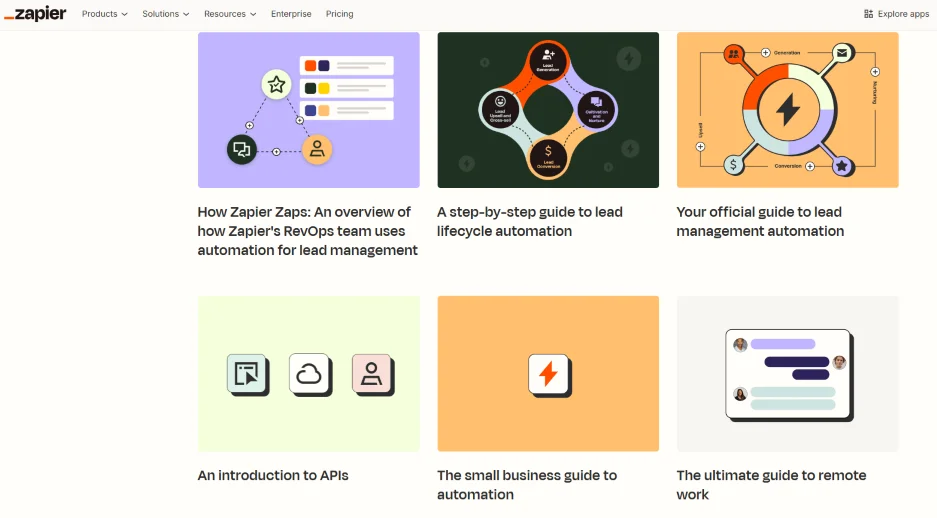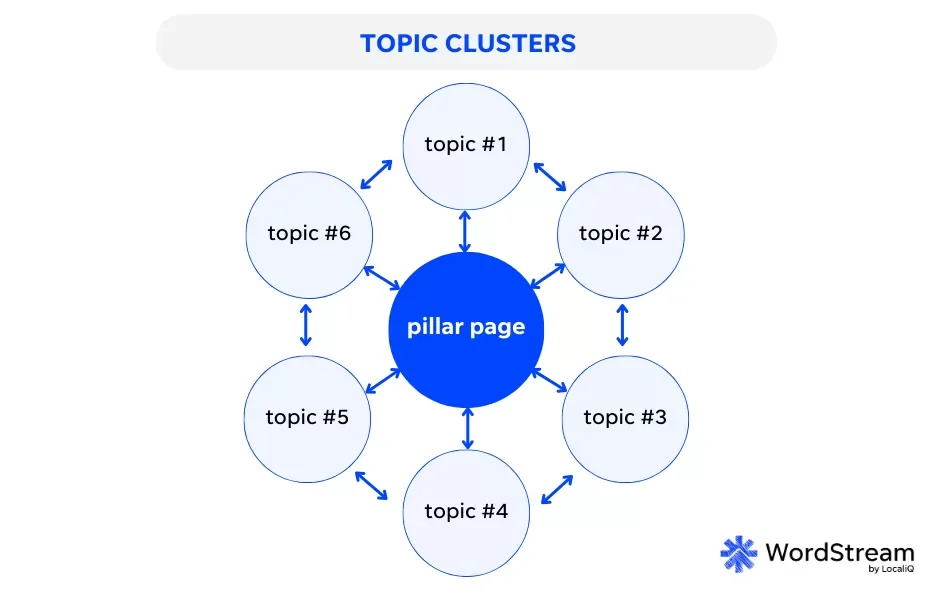In the zero-click era that we live in now, it’s not about producing more content. It’s about creating content that’s strategically structured to demonstrate expertise across an entire topic.
That’s where topical authority comes in. When your site connects the dots, answers the full range of questions, and shows clear ownership of a subject, that’s when trust starts to build.
Topical authority isn’t a growth hack. It’s building compounding interest. The more clearly and completely you cover a topic, the more visible and credible you become across queries, snippets, and even AI-generated summaries.
This guide shares 14 proven strategies for building topical authority, from internal linking to semantic structure. Follow it to turn scattered posts into a focused content system that gets noticed and remembered.
Contents
What is topical authority?
Topical authority is the deep, organized expertise your site conveys on a specific subject. It increases your ability to rank for related keywords. It’s not about publishing more content. It’s about covering a topic thoroughly and with intention.
The most effective sites aren’t content mills. They’re structured knowledge hubs. Instead of jumping between unrelated posts, they delve deeply into a core topic, exploring every angle and connecting the pieces through strategic internal linking. Over time, this creates a content ecosystem that’s greater than the sum of its parts.
Source
When you cover a topic completely, like animal health, you prove your authority with algorithms and visitors.
As Stephanie Yoder, Director of Content at Rebrandly, explains, “A content hub has to: 1. Be super important to your audience (otherwise, why invest the effort), 2. Be broad enough to warrant multiple posts that cover different facets of the topic, and 3. Have real SEO value. I typically look for overarching topics with lots of different dimensions. For example, ‘Employee Onboarding,’ which can then be broken down into subtopics like onboarding checklists, best practices, common mistakes, etc.”
When you structure your content this way (around a topic that matters, with clear depth and cohesion), you don’t just look authoritative. You become authoritative. That’s the signal Google is looking for and the kind of resource your audience will keep returning to.
📣 We’re just getting started! Get the free guide, 25 Ways to Increase Traffic to Your Website, now
Why does topical authority matter?
Topical authority isn’t just a best practice. It’s the bedrock of how modern search works.
Since Google launched the Helpful Content System, the algorithm favors sites that demonstrate genuine subject-matter expertise. Thin pages or disconnected posts won’t cut it. Search engines are looking for depth, clarity, and cohesion. These are now signals that show you’re not just creating content but answering real user intent.
That’s where topical authority gives you a strategic advantage. It improves your rankings, increases your relevance across long-tail queries, and builds lasting credibility.
Take Zapier, for example. Instead of publishing isolated tutorials, they built tightly structured guides, app comparisons, and use-case workflows. Each piece reinforces the others around core themes like automation and productivity.

Source
That interconnected ecosystem now drives thousands of ranking keywords, steady backlinks, and a compounding stream of non-branded traffic.
They don’t just rank for their product; they also rank for related products. They also rank for the problems their audience is trying to solve.
Topical authority makes you more visible, more trustworthy, and more useful. In a nutshell, that’s what Google is really measuring.
How Google evaluates topical authority
Google doesn’t publish an exact formula for measuring topical authority, but its behavior makes the framework clear. Here’s what Google is likely assessing:
- Coverage of related subtopics: Are you answering the full range of questions your audience asks around this topic? Gaps in coverage often signal a lack of expertise.
- Internal link structure: Do your articles connect logically, guiding users and crawlers through a well-structured knowledge graph? Strong clusters show intent and organization.
- External validation: Are you earning links, citations, or mentions from other reputable sources? Authority spreads when others in your space acknowledge your work.
- Semantic relevance: Are your topics aligned under a clear thematic umbrella, with consistent terminology and supporting entities? Google’s semantic systems prioritize coherence over keyword repetition.
For a deeper understanding of these signals, refer to Google’s documentation on search quality and its alignment with topical breadth, site structure, and credibility.
🛑 You need the right keywords to build topical authority. Use our Free Keyword Tool to find them fast.
14 ways to build topical authority
The good news is that you have considerable control over establishing authority on your website. These 14 strategies will make sure you’ve done it thoroughly.
Content strategy
The first four tactics will help you develop an authoritative content strategy.
1. Create comprehensive content hubs
Use a hub-and-spoke model, also known as content clusters, to organize your content. In this configuration, a central pillar page links to multiple subtopics, forming a semantic network Google can follow.

“A blog article scratches an itch. A hub cures the whole rash,” says Oskar Duberg, a Content Marketing Consultant. “If it has subtopics, stages, or variations worth unpacking, it probably needs its own structured home.”
2. Cover the entire topic, not just keywords
Use semantic tools like AlsoAsked and ChatGPT to discover subtopics. Your goal is to answer the complete set of user questions, not just high-volume queries.
A great example is Healthline’s diabetes content cluster. Rather than writing one article on “diabetes symptoms,” they built a full ecosystem, covering causes, treatment options, diet plans, medication guides, and FAQs. This breadth and depth helped them dominate SERPs for thousands of diabetes-related queries, earning both rankings and trust.

Source
3. Build supporting content around pillars
Think of your content ecosystem like a city grid: your pillar page is the downtown hub (e.g., “Diabetes: Symptoms, Causes, Treatment”), and the spoke articles are the surrounding neighborhoods that add depth and nuance.
Healthline follows this model masterfully. Their flagship diabetes pillar page includes links to detailed spokes such as:
Each spoke enriches the overall narrative and reinforces the central pillar. Together, they improve user navigation and signal depth and cohesion to Google.
4. Refresh and expand old content
Show Google that your content is actively maintained. Update older pages with new data, improved structure, and refreshed internal links to signal relevance.
HubSpot is a standout example. They’ve been doing this for years. They routinely refresh high-performing posts by adding new stats, clarifying outdated advice, and optimizing for featured snippets.
Refreshing content isn’t just maintenance. It’s leverage. Instead of starting from scratch, you’re building on assets that already have authority, backlinks, and a search history.
Structural signals
Once you’ve developed content depth, structure is what helps Google (and users) recognize it. These next tactics are all about creating structure.
5. Use internal linking strategically
Internal links are the backbone of any content cluster. They guide users, shape topic relationships, and help search engines understand what belongs together.
The key is intentional linking. Don’t just drop links for convenience. Connect related pages using descriptive anchor text that accurately reflects the actual subtopics. This helps Google recognize content relationships at scale.
Oskar explains it this way: “Treat your content like a city grid. If you need a spreadsheet to keep track, good—you’re doing it right.”
Think of your main topic pages as central hubs. Then, use internal links to connect them to relevant spoke pages that go deeper. Tools like Screaming Frog or Link Whisper can help you audit and optimize your structure.
6. Build clear URL structures around topics
URL structure matters for both humans and search engines. Clean, keyword-rich URLs make it easier to understand what a page is about and how it fits into a broader content system.
Poor URL structure:
example.com/blog?id=421
(Doesn’t tell you anything about the topic.)
Better URL structure:
example.com/seo/on-page-seo-guide
(Clearly signals the category and specific topic.)
Where possible, group related URLs under consistent folders or subdirectories (e.g., /seo/, /email-marketing/). This reinforces topic clusters and improves crawl efficiency.
7. Implement topic tags or categories
Categories and tags aren’t just for organizing your blog. They help Google understand what your content is about and how everything connects.
But here’s the catch: they only work when used strategically. Random or excessive tagging, often called “tag bloat,” can confuse both users and search engines. A well-planned taxonomy reinforces topical authority by making your site easier to crawl, navigate, and group by meaning.
Categories should align with your main content themes—the high-level topics your audience returns to.
Tags should highlight specific subtopics, use cases, or recurring ideas that show up across multiple posts.
Real-world small business examples:
- A local fitness coach’s blog
- Categories: Strength Training, Nutrition, Mindset
- Tags: Home Workouts, Protein Intake, Burnout, Meal Prep
- An ecommerce site selling eco-friendly home goods
- Categories: Kitchen, Bathroom, Cleaning Products
- Tags: Plastic-Free, Compostable, Low-Waste Tips, DIY Cleaners
- A digital marketing freelancer’s site
- Categories: SEO, Social Media, Email Marketing
- Tags: Google Business Profile, Instagram Reels, Lead Magnets, Deliverability
Each tag or category should support a topic cluster. If a piece of content doesn’t clearly belong anywhere, either rework it to align better or reconsider whether it needs to exist at all.

Source
Think of your taxonomy as a topic map for both readers and search engines. The clearer the structure, the stronger the authority signals it sends.
8. Add a table of contents to long-form posts
A table of contents (TOC) improves both usability and crawlability. It helps readers navigate longer guides without getting lost while also signaling subtopics to Google.
When each section in your TOC is linked with in-page anchors like the ones in this article (e.g., #what-is-topical-authority, #why-does-topical-authority-matter), you increase the chance of getting site links in SERPs or capturing featured snippet jump links.
On WordPress? Try the LuckyWP Table of Contents plugin for an easy implementation.
9. Use schema markup to enhance context
Schema markup adds a layer of structured meaning to your content, helping Google understand what type of content it is and how it should appear in search.
Here are a few useful schema types for content clusters:
- FAQ and HowTo: Ideal for practical subtopics or support-style articles.
- Article and Breadcrumb: Help define page structure and improve navigability.
- Organization, Author, and WebPage: Reinforce site credibility and ownership.
You can use tools like Google’s Structured Data Markup Helper or Schema.org to build valid markup or implement it using your CMS or SEO plugin.
Authority and trust signals
These final tips will help you demonstrate that your website has authority in a particular topic and highlight key trust signals to both readers and search engines.
10. Get backlinks from topic-relevant sites
Not all backlinks carry the same weight. A link from a general high-authority domain might boost your Domain Rating (an estimate of how likely your web pages are to rank in search), but what matters for topical authority is relevance. Google gives more weight to backlinks from sites that operate in the same niche or cover similar subject matter.
That’s because topical links signal endorsement from within your own knowledge space. If you run a financial coaching blog and get linked from a niche investing site, that tells Google your insights are trusted within the topic ecosystem, not just by the internet at large.
Pro tip: Prioritize niche guest posts, podcast features, or digital PR opportunities where your content contextually fits the audience. A link from a niche authority will always outrank a random inclusion on a generalist site.
11. Publish content written or reviewed by experts
Google aims to elevate content written by individuals with proven expertise, particularly in sensitive or complex fields such as health, finance, or law. But this applies more broadly to any competitive topic where trust matters.
That means slapping a byline on a post isn’t enough. You need to show credentials, explain your experience, and, in some cases, cite the expert who reviewed the content.

Source
“Publishing content for content’s sake won’t get you far,” Stephanie said. “To dominate a niche, you need to become a one-stop resource.”
Ways to demonstrate expertise:
- Include a short author bio that explains why this person is qualified to write about the topic.
- Add a “Reviewed by” section when content is medically, legally, or technically sensitive.
- Link to your authors’ LinkedIn profiles, credentials, or previous industry work.
12. Feature original research or insights
Few things build authority faster than original data.
Whether it’s a small survey, a large-scale study, or even just your own customer insights, publishing proprietary information positions your site as a source, not just a repeater.
It also earns backlinks. A standout example is Backlinko’s SEO Ranking Factors Study, which analyzed over 11 million search results. That one piece has earned thousands of citations from sites like Forbes, HubSpot, and Search Engine Journal—and continues to surface in AI-generated content summaries years later.

Source
“Original research gets quoted, linked, and resurfaced by AI tools whether you asked for it or not,” Oskar said. “It’s a multiplier, not just a tactic.”
Not sure where to start? Even small data sets, such as the results of a LinkedIn poll or anonymized trends from your customer base, can be effective when presented clearly and tied to a broader narrative.
13. Engage in thought leadership on the topic
Google doesn’t just crawl your blog. It also captures off-site trust signals, especially on platforms where authorship and authority are more visible, such as LinkedIn, YouTube, or podcasts.
By consistently sharing your thoughts in public, you reinforce both human trust and algorithmic trust in your name, brand, and domain.
Examples of thought leadership channels:
- LinkedIn articles or long-form posts
- Webinars, conference talks, or community events
- Guest spots on industry podcasts
- Contributed bylines (guest posting) on niche publications
You don’t need to be everywhere. But you do need to show up consistently in at least one or two places where your audience and Google can see that your expertise reaches beyond your own site.
14. Include expert quotes or collaborators
Bringing outside voices into your content is one of the easiest ways to boost credibility and often opens the door to natural backlinks or co-promotion.
Featuring an expert quote does three things:
- Adds trust and depth to your article
- Signals topical authority to Google via co-citation
- Makes the contributor more likely to share or link to your piece

Source
Tools like Help a B2B Writer and Featured make it easy to source expert input. But you can also reach out directly to respected voices in your niche.
Pro tip: Treat expert collaboration like content co-creation, not just a last-minute add-on. Build it into your workflow early so your piece can be shaped (and strengthened) by real insights from the start.
How to track topical authority progress
Topical authority isn’t a set-it-and-forget-it effort. Like any long-term strategy, it requires regular check-ins to measure progress and identify areas for improvement. Here are four high-signal metrics that tell you whether your efforts are paying off.
Keyword universe growth
Don’t just track a few target keywords. Track how your universe is expanding. Use SEO tools like Ahrefs, Semrush, or Google Search Console to see:
- If you’re showing up for more semantically related queries over time.
- If you’re capturing more long-tail keywords around your core topic.
Growth in keyword variety (especially in lower-difficulty terms) shows that Google sees your content as a relevant answer source across the topic spectrum.
Cluster ranking trends
Instead of monitoring post-by-post performance, zoom out. Are multiple pages in the same topic cluster moving up in rankings?
When Google starts ranking your ecosystem, not just individual pages, that’s a strong signal of topical authority. It means your internal structure is working, and your content is seen as a comprehensive resource.
Internal link coverage
Strong internal linking helps keep your topic clusters cohesive. Use Ahrefs or Screaming Frog to:
- Identify orphaned or weakly linked pages.
- Visualize internal link pathways between core topics and subtopics.
- Check if your most authoritative content is linking out to relevant spokes.
This is less about quantity and more about semantic logic. Internal links should reinforce how your ideas connect.
External recognition
Topical authority isn’t just about what’s on your site. It’s also reflected in how others reference it. Look for:
- Mentions or citations in peer blogs, newsletters, or industry publications.
- AI engine recognition (e.g., showing up in ChatGPT summaries or SGE panels).
- Natural backlinks to your guides, data, or frameworks.
When others view your site as the go-to source, Google often follows suit.
Future-proofing your topical authority strategy
SEO is evolving fast, but the core idea behind topical authority is built to last. Here’s how to stay ahead of the curve as search (and searchers) change:
Follow helpful content principles
Google’s Helpful Content System prioritizes content that’s written for people, not just for crawlers. This means:
- Don’t publish unless it solves a real problem.
- Prioritize clarity, completeness, and trustworthy sourcing.
- Cut the filler—depth doesn’t mean word count.
Topical authority isn’t about publishing more. It’s about building better answers across a structured topic map.
Adapt for generative AI
With AI Overviews and AI tools like ChatGPT shaping how people discover answers, topic depth matters more than ever.
AI systems summarize what they perceive as the most trustworthy and structured information. Sites that build clean, interconnected content clusters are more likely to be:
- Quoted directly in AI answers.
- Used as source material for summaries.
- Recommended as “further reading” in SGE carousels.
Investing in topic modeling and semantic structure now helps you stay visible and drive referral traffic from AI sources, even when search becomes less clickable.
Conduct quarterly audits
Topical authority compounds over time, but only if it’s maintained.
Once a quarter, run an audit to:
- Identify underperforming or outdated pages.
- Add internal links between new and legacy content.
- Expand gaps in your clusters (new questions, subtopics, tools, etc.).
Build topical authority and own the rankings
Google has moved from keyword matching to topic modeling. And that’s good news. Why? Because small sites can now compete with giants if they prove they know their stuff.
Start by mapping your core topics. Then, build content clusters around them, audit them quarterly, and keep sharpening the signal.
Topical authority isn’t just about ranking. It’s about earning trust, sustaining traffic, and becoming the site people (and algorithms) rely on.










